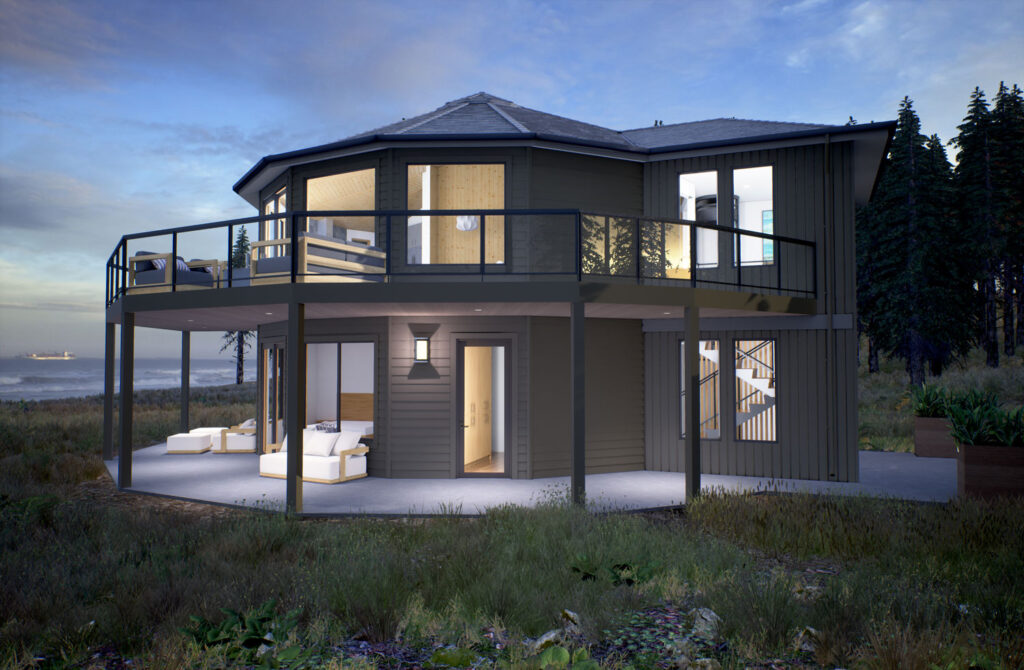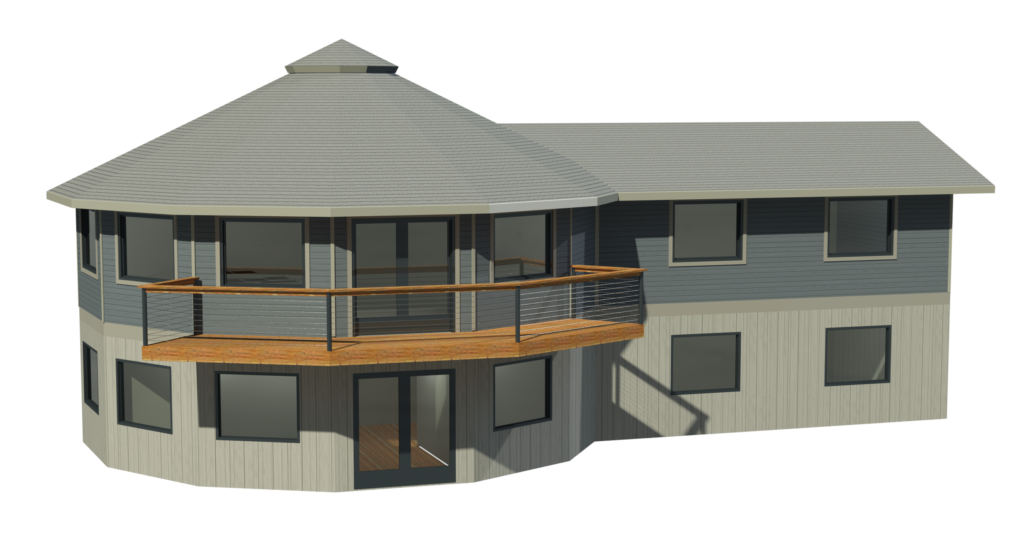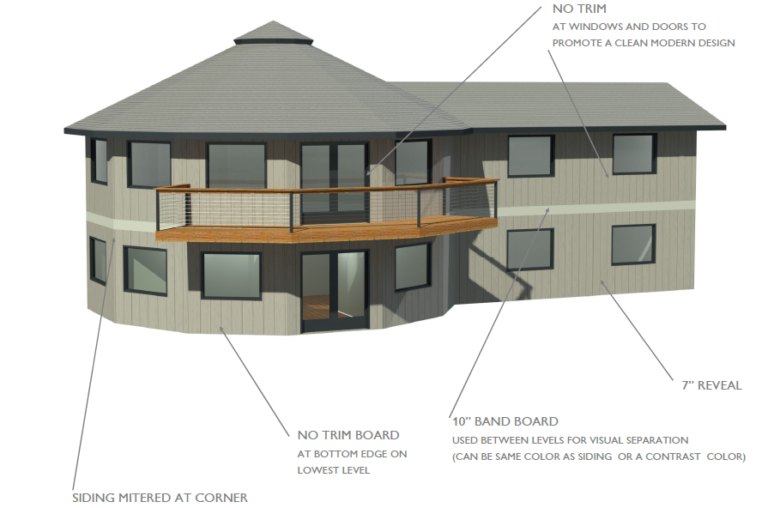One of the things that distinguishes Deltec Homes is the thought and intentionality that we put into new options. We don’t just select things but we look at emerging trends and products that make our homes better. Our new siding option does just that–combining both aesthetics and sustainability, giving you new opportunities to reduce your home’s carbon footprint.
A New Look Option Makes its Debut
Vertical siding is in, but our new polyash siding option, coming from Boral America’s TruExterior Crafstman collection, isn’t just any vertical siding. With a clean v-groove profile and smooth finish, this new siding design scheme also features trimless windows and doors, exposed fasteners, and clean mitered corners, offering a more modern aesthetic to our traditional 360 collection homes. This vertical siding can come pre-painted, and on round sections of our home, pre-installed, just like our popular lap siding.
Flexibility and Versatility
Clients can side their whole house in vertical siding, or mix this option with our other popular siding options: fiber cement lap siding, fiber cement shake siding, cedar lap siding, or cedar board on board siding. Varying textures on the same home are a great way to give it visual interest, as in the examples below:


A New Step Forward in Product Sustainability
But the best news yet: the innovative polyash material is highly sustainable. It is made of 70% recycled content, manufactured in a LEED certified facility that, like Deltec, uses renewable energy and carbon offsets, and is a is Cradle to Cradle Bronze certified product.
To help understand why Cradle to Cradle certification is so significant, we need to delve into some critical concepts in the world of material sustainability.
The Benefit of a Circular Economy
The circular economy is the idea that our manufacturing systems can create items from recycled materials, and that those items can then be recycled at the end of their useful life, and on and on. This idea was pioneered in the seminal environmental book Cradle to Cradle (the title for which the product certification is named). Circular economic thinking tackles environmental stewardship on both ends: looking at both the environmental harm caused by extraction and manufacture of a product, and then again the harm at the end of life due to disposal.
A true circular economy is not an easy thing to achieve, in the construction industry most particularly. Construction materials are often especially bulky and dense, energy intensive to produce, and difficult to recycle at the end of their service life. The equivalent carbon emissions associated with extracting and manufacturing a material is called its embodied carbon. Buildings have some of the highest embodied carbon of anything that humans create: accounting for 11% of equivalent global carbon emissions, according to the US Energy Information Agency. (That’s a separate accounting than the ongoing energy use of buildings, which is roughly 40% of equivalent global carbon emissions.)
Cement as a Building Material
Every building project is complex, using many different components with different usable lifetimes, and made from raw materials extracted and manufactured all over the country and even all over the world. Tracking down and precisely quantifying all of that embodied carbon is a tall order, but some trends are so clear their impacts dominate over others. In particular, cement is often by far the biggest aspect of a building’s embodied carbon, used in components such as foundations and some siding projects.
Why is cement such a factor in embodied carbon? Cement is an important and versatile material in human civilization, and yet, every aspect of the production and distribution of cement is resource-intensive, from extraction, to production, to shipping. A whopping 8% of total global carbon emissions come solely from cement.
Fiber cement siding has become a hugely popular choice for new homes, owing to it moisture resistance, rot resistance, fire resistance and low maintenance. You can stamp it to look like wood, it takes paint well, and requires re-painting much less often, than actual wood. For those seeking to build a resilient and low-maintenance structure, there’s a lot to love about it. Yet fiber cement siding is composed primarily of Portland cement and silica, with some small amount of wood fibers added in.
A Better Approach Than Cement
Polyash siding, by contrast, offers a different way of achieving the same low maintenance. Today, many concrete and brick mixes use fly ash, a bi-product of coal production, to reduce or eliminate Portland cement, and doing so is one of the most effective ways to recycle this otherwise problematic waste material. Boral’s innovative polyash siding takes this even further: binding fly ash to polymers to create a highly durable and stable siding material that boasts all of the same durability and paint-ability features as fiber cement. By re-purposing an otherwise nuisance waste material into a useful product, and doing so in place of a material that otherwise highly energy intensive to produce, polyash is a great example of circular economic thinking. Choosing this material can definitely have an impact on the total embodied carbon of a building product.
Did you know: Coal ash is the second largest waste product by volume in the US, after household trash. Even if every power plant stopped burning coal today, there would still be billions of tons of it around. Newsworthy spills of supposedly contained coal ash storage sites have happened in the US, causing environmental harm to land and water. Fly ash is one component of coal ash that can be recycled by replacing some of the cement in concrete. Boral’s polyash siding binds fly ash with polymers to safely encapsulate the fly ash and offer a very stable, workable, and durable siding material. This siding delivers the low maintenance and wood appearance of fiber cement siding while also repurposing a significant waste product.
When we think about sustainable buildings, we naturally spend a lot of time thinking about the energy, the health, and the durability of those buildings, because those are the attributes most tangible and most directly beneficial to the building owner. Yet true sustainability is about tracing all of the impacts a product or process has on the environment, and the selection of materials certainly has a role to play in the bigger picture of climate change and other large environmental challenges. Where possible, choosing materials with low embodied carbon, and those that contribute to a circular economy, is an important way to further build green.
Learn more:
Boral’s polyash story: https://truexterior.com/from-waste-to-wow-the-science-of-fly-ash/
Green Builder Magazine, the truth about fly ash: https://www.greenbuildermedia.com/buildingscience/the-truth-about-fly-ash
Cradle to Cradle Certification: https://www.c2ccertified.org/get-certified/product-certification
Environmental Building News’ statement on fly ash: https://www.buildinggreen.com/op-ed/ebns-position-fly-ash
